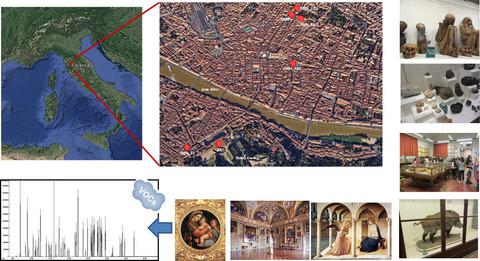当前位置:
X-MOL 学术
›
Indoor Air
›
论文详情
Our official English website, www.x-mol.net, welcomes your
feedback! (Note: you will need to create a separate account there.)
Indoor levels of volatile organic compounds at Florentine museum environments in Italy.
Indoor Air ( IF 4.3 ) Pub Date : 2020-03-09 , DOI: 10.1111/ina.12659 Tania Martellini 1 , Chiara Berlangieri 1, 2 , Luigi Dei 1, 2 , Emiliano Carretti 1, 2 , Saul Santini 1 , Angelica Barone 1 , Alessandra Cincinelli 1, 2
Indoor Air ( IF 4.3 ) Pub Date : 2020-03-09 , DOI: 10.1111/ina.12659 Tania Martellini 1 , Chiara Berlangieri 1, 2 , Luigi Dei 1, 2 , Emiliano Carretti 1, 2 , Saul Santini 1 , Angelica Barone 1 , Alessandra Cincinelli 1, 2
Affiliation

|
Indoor Air Quality monitoring in cultural institutions is of particular concern to protect these places and the cultural heritage content. An indoor monitoring campaign was performed in three museums in Florence (Italy) to determine the occurrence and levels of volatile organic compounds (VOCs). VOCs of interest included BTEX (benzene, toluene, ethylbenzene, xylenes), terpenes, aldehydes, organic acids, and cyclic volatile methyl siloxanes (cVMS). The most abundant VOCs in all samples analyzed were BTEX, which were strictly related to the traffic source, followed by siloxanes and terpenes. Among BTEX, toluene was always the most abundant followed by xylenes, ethylbenzene, and benzene. cVMS in exhibition rooms with the presence of visitors showed higher values compared to samples collected when the museums were closed. Terpenes showed not only the influence of vegetation‐biogenic sources surrounding a museum but could also be related to the wood used for the construction of showcases and furniture and the use of cleaning products. Data obtained also showed the presence of organic acids and aldehydes whose source can be traced back to exhibits themselves and wood‐based furniture. Assessing the levels of organic acids in museums is important because, over time, it can cause deterioration of the artifacts.
中文翻译:

意大利佛罗伦萨博物馆环境中的挥发性有机化合物室内水平。
为了保护这些地方和文化遗产的内容,文化机构中的室内空气质量监控尤为重要。在意大利佛罗伦萨的三个博物馆中进行了室内监测活动,以确定挥发性有机化合物(VOC)的含量和水平。感兴趣的VOC包括BTEX(苯,甲苯,乙苯,二甲苯),萜烯,醛,有机酸和环状挥发性甲基硅氧烷(cVMS)。在所有分析的样品中,VOC含量最高的是BTEX,其与流量来源严格相关,其次是硅氧烷和萜烯。在BTEX中,甲苯始终是最丰富的,其次是二甲苯,乙苯和苯。与博物馆关闭时收集的样本相比,在有观众参观的展览室中的cVMS显示出更高的价值。萜烯不仅显示出博物馆周围的植物生物来源的影响,而且还可能与用于陈列柜和家具的木材以及清洁产品的使用有关。所获得的数据还表明,存在有机酸和醛,其来源可以追溯到展品本身和木制家具。评估博物馆中有机酸的含量很重要,因为随着时间的流逝,它可能导致文物的恶化。
更新日期:2020-03-09
中文翻译:

意大利佛罗伦萨博物馆环境中的挥发性有机化合物室内水平。
为了保护这些地方和文化遗产的内容,文化机构中的室内空气质量监控尤为重要。在意大利佛罗伦萨的三个博物馆中进行了室内监测活动,以确定挥发性有机化合物(VOC)的含量和水平。感兴趣的VOC包括BTEX(苯,甲苯,乙苯,二甲苯),萜烯,醛,有机酸和环状挥发性甲基硅氧烷(cVMS)。在所有分析的样品中,VOC含量最高的是BTEX,其与流量来源严格相关,其次是硅氧烷和萜烯。在BTEX中,甲苯始终是最丰富的,其次是二甲苯,乙苯和苯。与博物馆关闭时收集的样本相比,在有观众参观的展览室中的cVMS显示出更高的价值。萜烯不仅显示出博物馆周围的植物生物来源的影响,而且还可能与用于陈列柜和家具的木材以及清洁产品的使用有关。所获得的数据还表明,存在有机酸和醛,其来源可以追溯到展品本身和木制家具。评估博物馆中有机酸的含量很重要,因为随着时间的流逝,它可能导致文物的恶化。









































 京公网安备 11010802027423号
京公网安备 11010802027423号